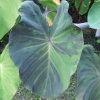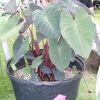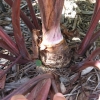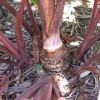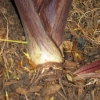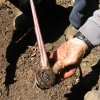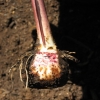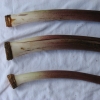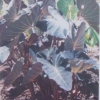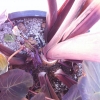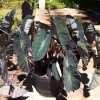Use As Food
Makes a high-quality smoky-gray poi; formerly highly prized for medicinal purposes and as an offering to the ancient Hawaiian gods; especially for Pele.
Distribution
Formerly grown to some extent at ‘Ewa, O‘ahu, under wetland culture, but at present found most commonly on the Big Isle of Hawai‘i and occasionally on Kaua‘i, under upland, dryland culture (māla).
General Characteristics
Medium in height, slender, moderately spreading, maturing in about 12 months, producing fairly numerous ‘ohā (usually over 10); readily identified by patchy color (mottled) green and purplish Lau or lū ‘au (Leaf blade).
Ha (Petiole)
70 to 85 cm. long, slender, lilac-purple flecked with streaks of purplish-black especially on lower half, distinctly purplish-black at edge, at kōhina (base), the apex whitish on outer surface and reddish-purple on inner.
Lau or Lu'au(Leaf Blade)
40 to 50 cm. long, 25 to 35 cm. wide, 30 to 40 cm. from tip to base of sinus (māwae). Arrow head shaped, fairly concave (curve inward), conspicuously patchy color (mottled) with green and dark purple especially on lower surface; margins quite wave-like (undulate); piko purple; veins light reddish-purple on lower surface of round leaf section (lobes); round leaf section (lobes) obtuse to slightly acute with deep, narrow lihi māwae (sinus).
'I'o kalo (Corm)
Flesh white with yellowish fibers; skin white with pink or light to dark purple leaf-scar rings.
Pua (Flower)
Flower part (Inflorescence): Hā (peduncle) lilac-purple with occasional dark purple streaks flower cover (spathe) 18 to 24 cm. long, the lower tubular portion 3 to 4 cm, long, green with lilac-purple flecks and a few purple streaks, the upper portion yellow, tightly rolled or sometimes open near constriction (skinny part of flower); spadix (spike of flower) 6 cm. long, the sterile appendage (tip of flower's spike) 6 mm. long.
Remarks
This variety has many of the characteristics of the kā ī group, in particular the tough, rubbery consistency of the cooked ‘i‘o kalo (Corm). This variety can be confused with Black Magic, # 201, a variety popular with landscapers. Uahiapele is different from Black Magic in the following ways: 1. Black Magic’s leaf is more uniform in color while Uahiapele is splotches of charcoal grey and green mixed in; 2. Black Magic’s piko (center) matches the color of the rest of the leaf while Uahiapele’s piko is a differently colored bright purple dot; 3. Black Magic’s kōhina (base) is bright green, while Uahiapele’s kohina is white; 4. Black Magic's stem is all the same shade of purple. But Uahiapele's Hā (stem) features a distinctly black-purplish edge (lihi), that looks like a stripe. 5. is a Black Magic reproduces by sending out runners (rhizomes) to become keiki, while Uahiapele’s keiki (‘ohā) grow directly from the main corm.


